Cultivation of Kalanchoe at home. Signs and recommendations of Feng Shui.
Contents of
- What is a Kalanchoe blooming, how it looks like it is blooming: description of
- Kalanchoe - can I keep at home: the value of a flower, signs and superstitions
- How to water a Kalanchoe in winter and summer at home?
- How to transplant a flowering Kalanchoe?
- What kind of land do you need for a Kalanchoe?
- How does the flowering Kalanchoe multiply?
- How to trim a Kalanchoe after flowering?
- Why do the Kalanchoe turn yellow, spin, dry and fall off the leaves?
- Kalanchoe does not bloom and pulls up: what should I do?
- Feeding Kalanchoe
- Where should the Kalanchoe flower stand on Feng Shui?
- Video: how to care for a flowering Kalanchoe at home?
Plants in human life play different roles. They are medicine, weeds, and pets. Among the latter, the Kalanchoe has a worthy place among the housewives.
It expands and gives a long flowering in response to reasonable care and attention. Although it is recognized as an unpretentious plant in terms of irrigation, fertilization and transplantation.
Is this really so? Let's continue to understand the article.
What is a Kalanchoe blooming, how it looks like it is blooming: description of
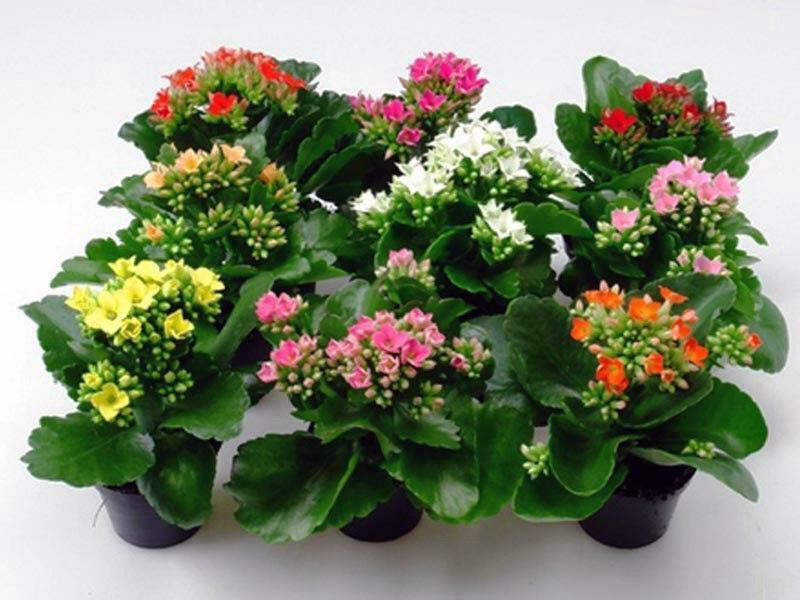 blooming Kalanchoe in pots
blooming Kalanchoe in pots Kalanchoe in our latitudes are hybrids of plants from Madagascar. It refers to succulents, a family of peas. In total, more than 200 of its species are known.
The maximum spread and popularity has acquired the Kalanchoe blossoming varieties such as:
- Blossfelda
- pinnate
- Daigremont
- one-flowered
External parameters of the plant:
- low to 30 cm
- leaves large fleshy elastic, oval in shape with serrated edges
- flowers are small, joined in inflorescences
- flower shape - tube with 4 petals
- during flowering cover the surface of the plant with a dense carpet
- gamma - from white to saturated red
Kalanchoe - mzhno whether to keep the house: the value of the flower, signs and superstitions
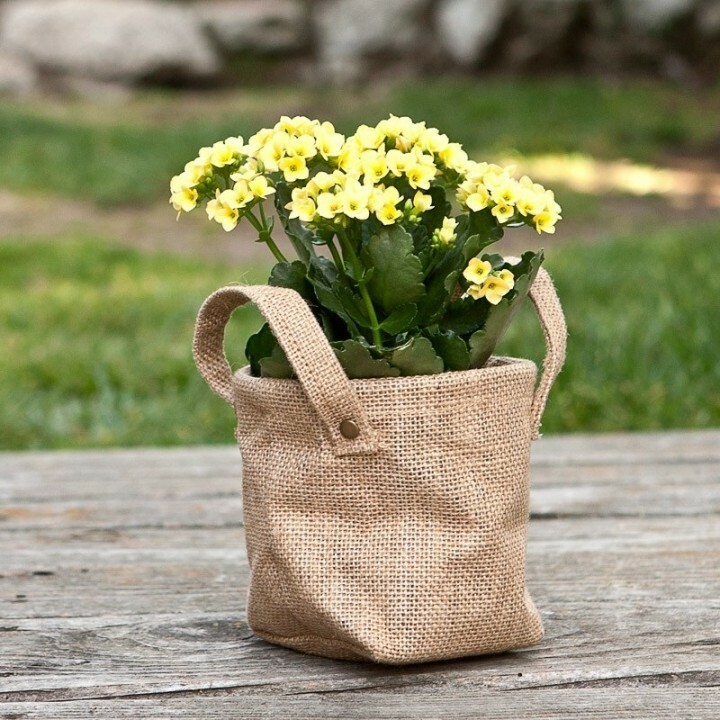 flowering kalanchoe in eco-bag - a great gift for all occasions
flowering kalanchoe in eco-bag - a great gift for all occasions Kalanchoe has healing properties, it is useful to humans. Therefore, be sure to get yourself this plant. It is patient enough and takes minimal care of itself with gratitude.
As for the signs, they all have a positive value. Kalanchoe is not a magnet for dark forces, outbursts of quarrels and abuse, illnesses and troubles.
Conversely: the
- Kalanchoe absorbs the heavy energy accumulated at the end of your day of work
- clears the aura at home, takes the negative from the space
- promotes the harmonization of relationships in the family
- encourages the change of negative thoughts to positive
- gathers the family together for pleasant conversations
- if your Kalanchoe bloomed,then in the house reign, peace and harmony
However, think about it if:
- your green pet suddenly faded and died, then he assumed an external dark attack directedand the destruction of the harmony of your family,
- he lives with you for many years and does not bloom, then your family no sincerity, depth of relationship harmony.
How to water Kalanchoe in winter and summer at home?
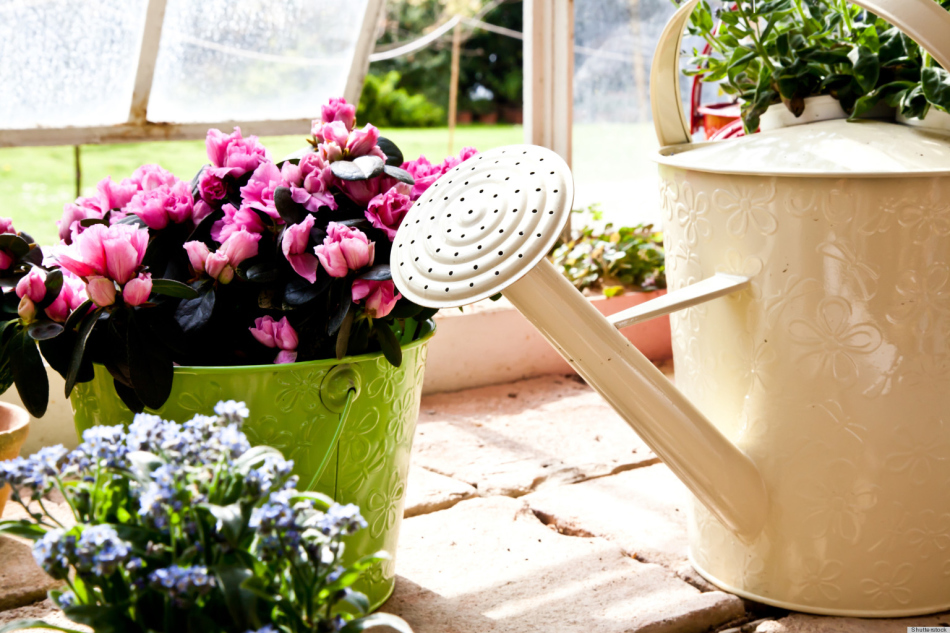 Watering can near pots with Kalanchoe
Watering can near pots with Kalanchoe As the Kalanchoe is not a fastidious plant, it is not difficult to take care of it.
On the other hand, like any other green resident of your home, it is sensitive to an excess of moisture, cold, complete absence of sunlight.
In the summer, water the Kalanchoe sparingly with a frequency of once a week.
- Choose water that has been settled indoors for a day.
- Avoid pouring cold tap water under the roots of the Kalanchoe.
- Leave the stalk of the plant without drops of moisture, so that it does not provoke disease.
- Soak the soil so that water does not remain on the surface and in the pan of the pot. In the second case, immediately pour it out.
- Remember that a Kalanchoe comes from the tropics, therefore it is easier to tolerate a short period of drought than an excessive amount of water in the soil. After all, he is inclined to accumulate moisture in his leaves and stems, which he uses in the drought period.
In winter, the periodicity of watering is reduced to 1.5-2 weeks.
- Gently lift the leaves before watering. Avoid accumulating water on them in order to avoid the initiation of decay and disease processes.
- Reduce the amount of water for one irrigation by half. It is better to wait for the complete drying of the soil in the pot from the Kalanchoe and then pour in than adding the liquid to the moist soil. So you reduce the likelihood of plant freezing and its stress from the watering procedure.
- The water temperature should be no lower than room temperature, in which the Kalanchoe lives.
The general principle for watering at any time of year is a good impregnation of an earthy coma, but without a gulf.
How to transplant a flowering Kalanchoe?
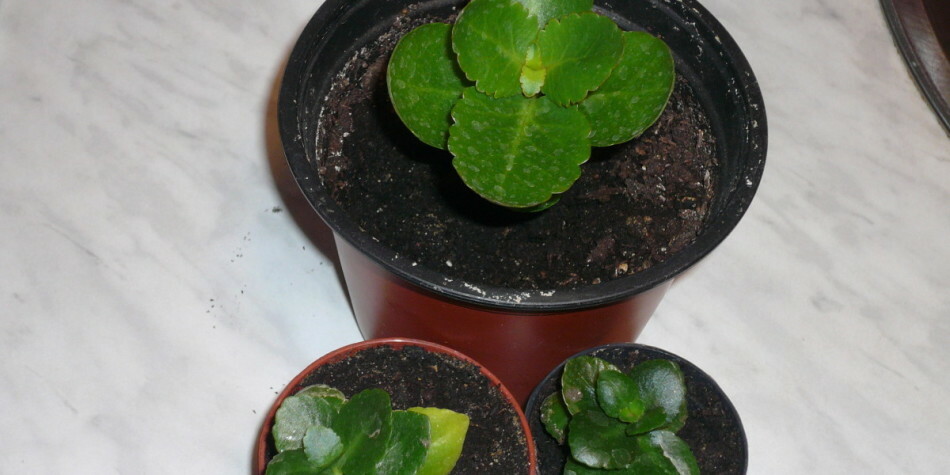 young potters of Kalanchoe in pots after the
young potters of Kalanchoe in pots after the transplant Take into account a number of parameters before the transplant:
- diameter of the new pot choose a couple of centimeters more than the previous
- schedule the procedure for the end of March and the middle of April and repeat every year
- keep the soil composition to accelerate adaptation of the plant
Procedure:
- fill the new pot with drainage and primer for 50%
- carefully remove the Kalanchoe from the old pot. Leave its roots with an earthy lump
- set in a new flowerpot and add the soil
- lightly pound around the stalk soil
- mildly pour the plant in a new pot
- feed it for a week until the complete adaptation of the
What kind of land is needed for the Kalanchoe?
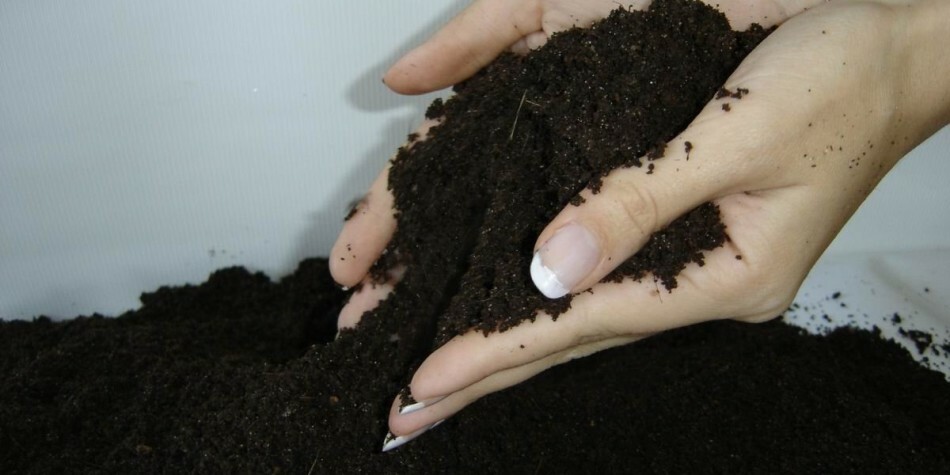 mixture of soil in the hands of a girl before falling asleep in pots for transplanting Kalanchoe
mixture of soil in the hands of a girl before falling asleep in pots for transplanting Kalanchoe The ideal composition of the soil for transplanting and growing a Kalanchoe house is a combination of elements from equal whole and half parts. Namely:
- of leaf humus, turf and coarse sand taken in equal integer parts of
- charcoal and brick crumbs - in halves
Use bone meal as a fertilizer. It is enough 1 g per liter of soil mixture.
- Observe the acidity index of the soil for Kalanchoe. The first is able to vary within 5.0-6.5 pH.
- You can either buy the ready mix in specialized stores, or cook by yourself. In the second case, additional sterilization is needed.
How does the flowering Kalanchoe multiply?
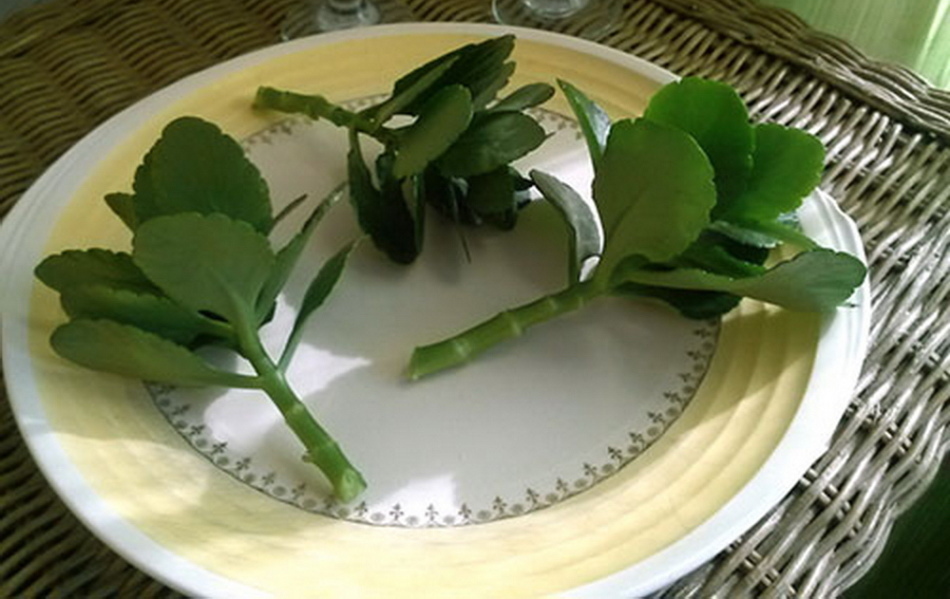 healthy seedlings of Kalanchoe on a plate before planting
healthy seedlings of Kalanchoe on a plate before planting Blossoming Kalanchoe can propagate in 2 ways:
- with vegetative, i.e. cuttings,
- leaves with
seeds. In the first case, choose:
- healthy material,
- warm season, when the duration of the light part of the day is not less than 12 hoursand the temperature does not fall below + 24 ℃, the
- is a well-lit place, but without direct sunlight.
In the second:
- is another composition of the soil. It should be made of peat and sand, taken in equal parts,
- a regularly ventilated room with a temperature not lower than + 18 ℃,
- , warming the pot with cellophane before germination of the seeds. Usually it occurs 7-10 days after sowing.
How to trim a Kalanchoe after flowering?
 cropped flower stalk at Kalanchoe after withering of all colors
cropped flower stalk at Kalanchoe after withering of all colors - Make sure all the flowers are wilted.
- With garden scissors, remove the flower spike as low as possible to the roots. Then no fungi and mold are not terrible to him.
- And also cut the last 2 leaves on each branch of the plant. In this way, you will stimulate the growth of the calanchoe in the correct oval shape.
Kalanchoe should be pruned not only after flowering, but after purchase and with preventive purposes.
Why does the Kalanchoe turn yellow, spin, dry and fall off the leaves?
 in Kalanchoe dry leaf tips
in Kalanchoe dry leaf tips The reasons for this phenomenon are somewhat depending on the nature and location of the affected leaves.
- If this is only the top, then the plant does not have enough sun light.
- If only the lower ones - you allowed the drying of the soil and did not water the Kalanchoe for a long time. And also, perhaps, under his pot is too hot battery. So change the place to cooler.
For a few more reasons:
- potty tightness,
- aging of the plant, which means it's time to pluck out its healthy shoots / leaves and take measures to rejuvenate,
- damage aphids if a similar situation manifests itself in the summer, and the plant itself lives on the balcony or in your garden.
Kalanchoe does not bloom and pulls up: what should I do?
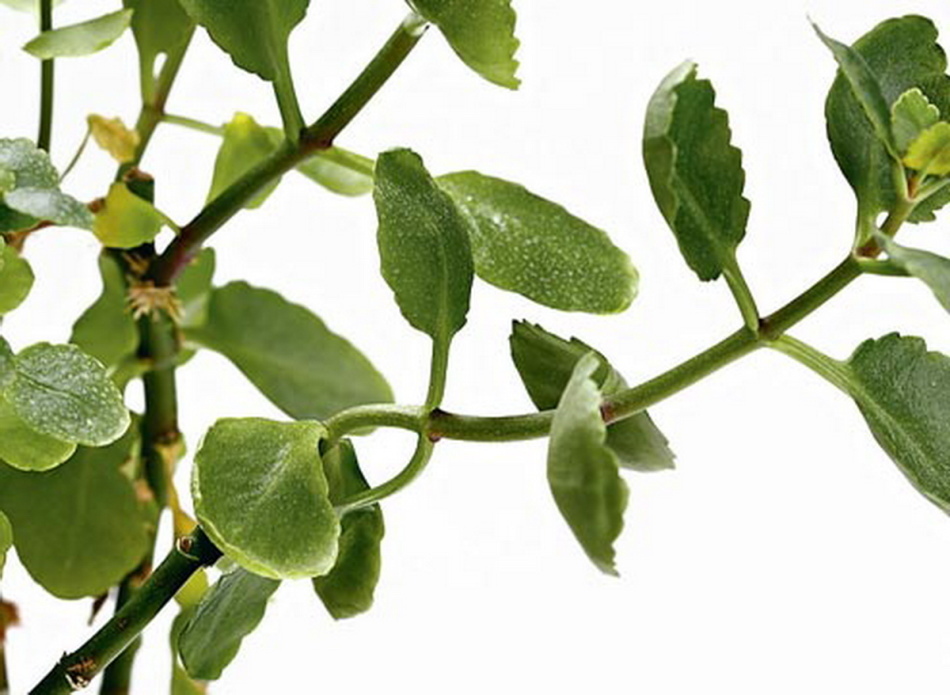 Kalanchoe stretched up and without flowers
Kalanchoe stretched up and without flowers First, determine the possible cause. This is either:
- lack of sunlight, beyond which stretches the plant
- too long light day, which is 12 or more hours
Exit from the current situation, too, 2:
- rearrange the pot from the Kalanchoe to the window sill without any neighbors except succulents,
- to monitor the durationday for the plant, cover it with opaque polyethylene in the evening until morning.
Kalanchoe begins to form peduncles when:
- has enough strength, that is, watering and feeding is OK
- , it sees sunlight no more than 10 hours in a row.
Kalanchoe feeding
Choose ready-made fertilizers for succulents and reduce the recommended dose on a pack twice. So you feed the Kalanchoe without harm to his health.
Frequency of fertilizer application - once a month.
Another option is special complex nutrient mixtures for flowering plants. They are good for Kalanchoe, which please the owners with bright colors.
Where should the flower of the Kalanchoe for Feng Shui stand?
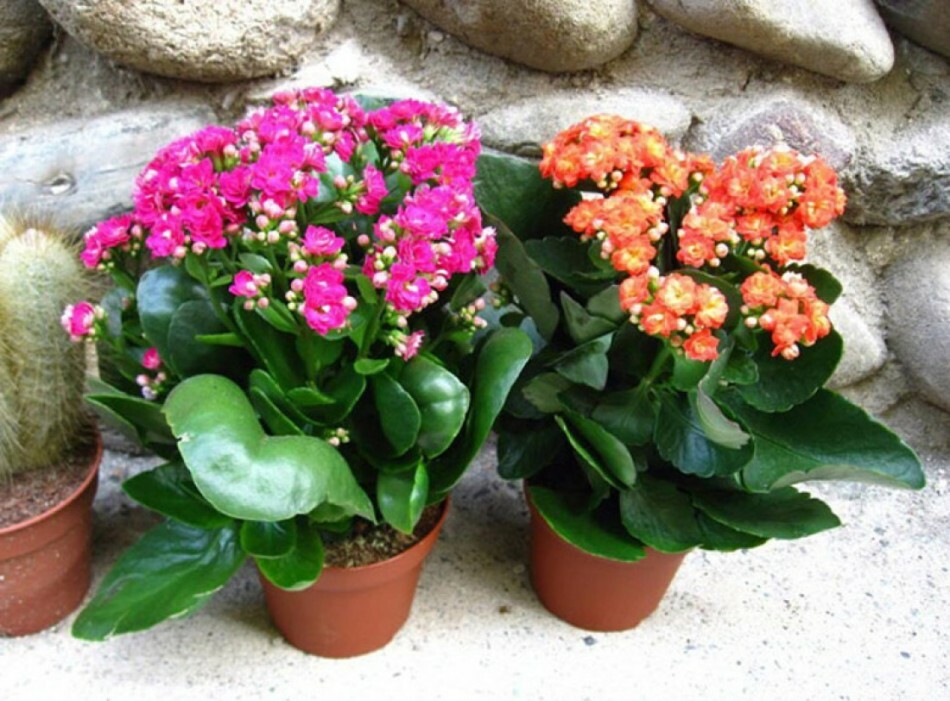 blooming Kalanchoe is located on the southern side of the house, because the blooming flower is
blooming Kalanchoe is located on the southern side of the house, because the blooming flower is According to Feng Shui, the best locations for the Kalanchoe are:
- window sills on the southern side of the house,
- extreme left corner of the dwelling - to attract abundance and wealth to the hosts,
- left corner from the computer monitorfor those who work in the dark. The plant absorbs fatigue and replenishes the strength of the worker.
So, we have considered the main stages of care for a flowering Kalanchoe, the reasons for its drying and pulling up. We learned about the benefits and favorable signs from the presence of plants in the house.
Get a Kalanchoe if you have not already done so, and check in practice the strength of its healing effect.
